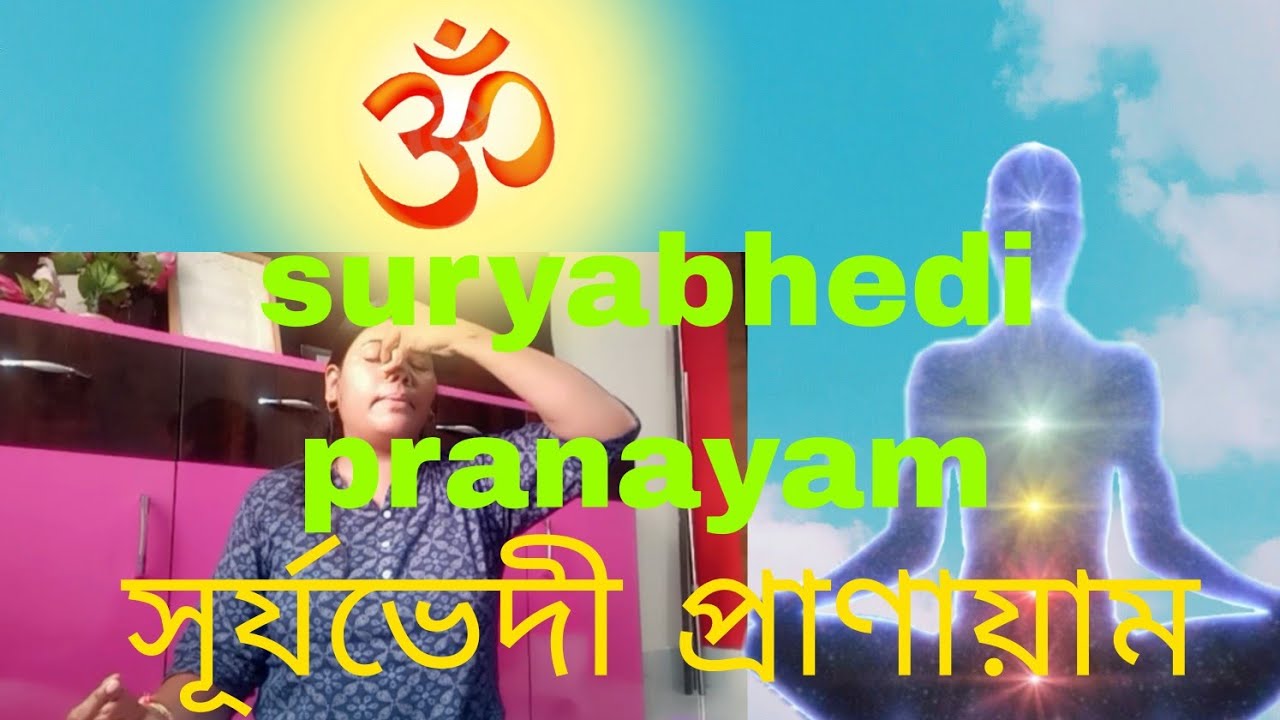
Suryabhedi & Chandrabhedi Pranayama Energy Balance
What is suryabhedi and chandrabhedi pranayama yoga tips to manage energy imbalance? This is a question many yoga enthusiasts ask, especially those seeking a deeper understanding of their energetic well-being. These two pranayama techniques, often referred to as sun and moon breathing, are powerful tools for balancing the subtle energies within our bodies, helping to alleviate imbalances that manifest as physical and emotional symptoms.
We’ll delve into the specifics of each practice, exploring how they impact our energy flow and offering practical tips to integrate them into your daily life.
We’ll uncover the secrets behind Suryabhedi and Chandrabhedi pranayama, exploring their physiological effects and how they interact with the Ida and Pingala nadis, the subtle energy channels running along the spine. We’ll examine how imbalances in these nadis can manifest as various physical and emotional symptoms, and how these specific breathing techniques can help restore equilibrium. Get ready to discover how you can harness the power of breath to cultivate a sense of inner harmony and vitality.
Introduction to Suryabhedi and Chandrabhedi Pranayama
Suryabhedi and Chandrabhedi pranayama are two powerful breathing techniques in yoga that influence the Ida and Pingala nadis, respectively. These nadis are subtle energy channels believed to run along the spine, carrying prana (life force). By consciously directing the breath through these channels, we can influence the energetic balance within the body, impacting both physical and mental well-being.
Understanding their distinct effects and proper execution is crucial for harnessing their benefits safely and effectively.
Physiological Effects of Suryabhedi Pranayama
Suryabhedi pranayama, also known as the “sun-piercing breath,” primarily stimulates the right nostril and the Pingala nadi. This stimulation is associated with increased sympathetic nervous system activity. Physiologically, this translates to increased alertness, heightened energy levels, improved metabolism, and potentially a rise in blood pressure and heart rate. It’s often used to invigorate the body and mind, particularly in the mornings.
The increased metabolic activity can aid in digestion and potentially contribute to weight management when practiced consistently as part of a holistic approach. However, it’s crucial to remember that these effects are not guaranteed and vary based on individual physiology and practice.
Physiological Effects of Chandrabhedi Pranayama
Chandrabhedi pranayama, the “moon-piercing breath,” focuses on the left nostril and the Ida nadi, which is associated with the parasympathetic nervous system. This stimulation leads to a calming effect on the body and mind. Physiologically, this can manifest as reduced heart rate, lower blood pressure, decreased anxiety, and a sense of relaxation. It’s often recommended for calming the nerves before sleep or during periods of stress.
The calming effect can also improve sleep quality and reduce feelings of restlessness. Similar to Suryabhedi, individual responses can vary.
Energetic Effects: A Comparison of Suryabhedi and Chandrabhedi Pranayama
Suryabhedi and Chandrabhedi pranayama exert opposite energetic effects. Suryabhedi increases energy, promotes alertness, and activates the Pingala nadi, associated with masculine energy, heat, and action. Chandrabhedi, conversely, promotes calmness, relaxation, and activates the Ida nadi, associated with feminine energy, coolness, and introspection. Balancing these two practices can help maintain a harmonious flow of energy within the body, preventing imbalances that might lead to physical or emotional distress.
Practicing one without the other can lead to an imbalance, so a balanced approach is usually recommended.
Step-by-Step Guide to Suryabhedi Pranayama
The following table Artikels the steps involved in performing Suryabhedi pranayama. Consistent practice and attention to detail are key to reaping its benefits. Remember to consult with a qualified yoga instructor before starting any new pranayama practice, especially if you have underlying health conditions.
| Step | Breath Control | Visual Description | Common Mistakes to Avoid |
|---|---|---|---|
| 1. Comfortable Posture | Natural Breath | Sit comfortably in a cross-legged position (Sukhasana) or on a chair with a straight spine. Imagine a straight line extending from the crown of your head to the base of your spine. | Slouching or hunching, which restricts breath flow. |
| 2. Right Nostril Breathing | Inhale and exhale through the right nostril, using your right thumb to gently close the left nostril. | Gently press the left nostril closed with the right thumb, keeping the right nostril open for both inhalation and exhalation. Maintain a steady and controlled breath. | Forcing the breath or applying excessive pressure to the nostrils. |
| 3. Breath Count | Maintain a consistent count for inhalation, retention (optional), and exhalation. Start with a count of 4-6 seconds for each phase. | Visualize the breath entering and leaving your body. Focus on the sensation of the breath. | Inconsistent breath counts leading to irregular breathing patterns. |
| 4. Repetition | Repeat steps 2 and 3 for a few minutes, gradually increasing the duration as you become more comfortable. | Maintain awareness of the breath and your body’s response to the practice. | Holding your breath for too long or forcing the breath. |
Energy Imbalances and Their Manifestations
In Ayurveda, the ancient Indian system of medicine, the body’s energy is understood through the lens of three doshas: Vata, Pitta, and Kapha. These doshas represent different energetic principles and their balance is crucial for overall health and well-being. An imbalance in these doshas, often linked to the dominance of either the Ida or Pingala nadi (lunar and solar energy channels respectively), can manifest in various physical and emotional symptoms.
Understanding these imbalances is key to utilizing pranayama techniques like Suryabhedi and Chandrabhedi effectively.Ayurveda posits that an excess or deficiency of Vata, Pitta, or Kapha can disrupt the delicate equilibrium within the body, leading to disease. This disruption is often reflected in the energy flow through the Ida and Pingala nadis, the subtle energy channels that run alongside the spinal cord.
An overactive Pingala nadi (solar energy) can lead to a state of excess Pitta and possibly Vata, while an overactive Ida nadi (lunar energy) often correlates with an excess of Kapha and potentially Vata.
Excess Solar Energy (Pingala Nadi Dominance)
Dominance of Pingala nadi, associated with the sun’s energy, is often characterized by an excess of Pitta dosha. This can manifest as heightened feelings of anger, frustration, and irritability. Physically, individuals might experience inflammation, heartburn, ulcers, or skin conditions like rashes or acne. The individual may also feel overly ambitious, driven, and potentially experience insomnia due to racing thoughts.
This state is often marked by a heightened metabolic rate and increased heat production in the body. It’s crucial to remember that these symptoms can vary greatly in intensity and presentation depending on individual constitution and other factors.
Excess Lunar Energy (Ida Nadi Dominance)
Conversely, an overactive Ida nadi, associated with the moon’s energy, often indicates an excess of Kapha dosha. This might lead to lethargy, sluggishness, and a tendency towards depression or anxiety. Physically, symptoms could include water retention, weight gain, congestion, and a general feeling of heaviness or sluggishness. Individuals may experience a lack of motivation, feeling overwhelmed and emotionally stagnant.
The body’s metabolic rate may be slower, and there might be a tendency towards increased mucus production. Again, the severity and specific presentation of these symptoms can vary significantly.
Suryabhedi and Chandrabhedi pranayama are amazing yoga breathing techniques to balance your energy – think of it like tuning your body’s internal thermostat. Maintaining this balance is crucial for overall well-being, and interestingly, research suggests that even subtle energy imbalances might be linked to later health issues, as highlighted in this article on whether an eye test can detect dementia risk in older adults: can eye test detect dementia risk in older adults.
Mastering these pranayama techniques can be a powerful tool in preventative self-care, helping to maintain a harmonious energy flow throughout your system.
Energy Imbalances and Their Manifestations: A Summary
The following table summarizes the connections between energy imbalances, their potential causes, associated nadis, and suggested pranayama practices:
| Symptom | Potential Cause | Associated Nadi | Suggested Pranayama |
|---|---|---|---|
| Anger, Irritability, Heartburn | Excess Pitta, Stress | Pingala (overactive) | Chandrabhedi |
| Lethargy, Depression, Weight Gain | Excess Kapha, Lack of Activity | Ida (overactive) | Suryabhedi |
| Anxiety, Insomnia, Racing Thoughts | Vata Imbalance, Overthinking | Pingala (overactive) or Ida (overactive) | Nadi Shodhana (Alternate Nostril Breathing) |
| Constipation, Dry Skin, Irregular Sleep | Vata Imbalance, Dehydration | Ida (underactive) or Pingala (underactive) | Dirga Pranayama (Three-Part Breath) |
Applying Suryabhedi and Chandrabhedi for Energy Balance: What Is Suryabhedi And Chandrabhedi Pranayama Yoga Tips To Manage Energy Imbalance

Source: ytimg.com
Suryabhedi and Chandrabhedi pranayama are powerful tools for balancing the body’s energy. By consciously directing the breath through specific nostrils, we can influence the flow of prana, the vital life force, and address imbalances manifested as physical or emotional symptoms. Understanding how each technique works is key to effectively utilizing them for improved well-being.
Suryabhedi Pranayama and Excess Lunar Energy
Suryabhedi, or sun-piercing breath, is associated with the Pingala nadi, the right nostril channel linked to solar energy. Practicing Suryabhedi is particularly beneficial when there’s an excess of lunar energy, often characterized by lethargy, emotional instability, and a tendency towards introversion. The energizing, warming effect of this pranayama stimulates the sympathetic nervous system, counteracting the calming, cooling influence of the parasympathetic system associated with excess lunar energy.
This shift helps restore balance by promoting alertness, focus, and a more assertive disposition. Regular practice can lead to increased energy levels, improved digestion, and a heightened sense of confidence.
Chandrabhedi Pranayama and Excess Solar Energy
Chandrabhedi, or moon-piercing breath, focuses on the Ida nadi, the left nostril channel connected to lunar energy. When solar energy is dominant, leading to symptoms like anxiety, irritability, and restlessness, Chandrabhedi provides a cooling and calming effect. This pranayama stimulates the parasympathetic nervous system, promoting relaxation, reducing stress, and fostering a sense of inner peace. By channeling the breath through the left nostril, we tap into a more introspective and calming energy, helping to balance the overstimulation associated with excess solar energy.
This can improve sleep quality, reduce blood pressure, and cultivate emotional stability.
Benefits of Practicing Both Techniques
Practicing both Suryabhedi and Chandrabhedi pranayama offers comprehensive energy balancing. While one might address a specific imbalance, the combined practice creates a dynamic interplay, promoting a more holistic and sustainable equilibrium. Regular alternation between these two techniques helps to prevent the dominance of either solar or lunar energy, fostering a state of inner harmony and improved overall well-being.
This balanced approach enhances the body’s natural self-regulating mechanisms, leading to improved physical and mental health.
Integrating Suryabhedi and Chandrabhedi into a Daily Routine
Integrating these pranayama techniques into your daily routine requires consistency and mindful practice. Start with shorter sessions and gradually increase the duration as you become more comfortable.
- Begin with 5-10 minutes of each pranayama daily, gradually increasing the duration to 15-20 minutes.
- Practice in a quiet, comfortable space where you can relax and focus.
- Maintain a comfortable posture, either seated or lying down.
- Focus on your breath, observing the sensation of the air entering and leaving your nostrils.
- Alternate between Suryabhedi and Chandrabhedi, perhaps starting with one and ending with the other.
- Pay attention to your body’s response and adjust your practice accordingly. If you feel overwhelmed, shorten the duration or take breaks.
- Observe how your energy levels fluctuate throughout the day and adjust your practice to address any imbalances.
Advanced Techniques and Considerations
Suryabhedi and Chandrabhedi pranayama, while offering significant benefits for energy balance, are powerful techniques that require careful approach. Understanding potential risks, adapting the practice to individual needs, and mastering modifications for beginners are crucial for safe and effective use. Ignoring these aspects can lead to discomfort or even adverse effects.
Potential Risks and Contraindications
These pranayama techniques, like any other yogic practice, are not without potential risks. Individuals with high blood pressure, glaucoma, insomnia, or heart conditions should approach these practices with extreme caution, ideally under the guidance of an experienced yoga instructor. Pregnant women and those recovering from surgery should also avoid these practices without consulting a healthcare professional. Furthermore, practicing these techniques improperly can lead to dizziness, headaches, or feelings of anxiety.
It’s vital to listen to your body and stop if you experience any discomfort. Overexertion can negate the benefits and potentially cause harm.
Adjusting the Practice Based on Individual Needs and Energy Levels
The intensity and duration of Suryabhedi and Chandrabhedi pranayama should be adjusted based on individual energy levels and experience. Beginners should start with shorter durations and fewer rounds, gradually increasing the practice as their body adapts. On days with lower energy, a gentler approach is recommended, focusing on shorter breaths and fewer repetitions. Conversely, on days with higher energy levels, one might increase the duration and repetitions, but always remaining mindful of the body’s signals.
It’s essential to prioritize consistency over intensity. Regular, even short, practices are more beneficial than infrequent, intense sessions.
Modifying Pranayama Techniques for Beginners
For beginners, it’s advisable to start with a shorter duration, perhaps 1-2 minutes for each practice, and a smaller number of repetitions, say 5-10. Focus on smooth, controlled breathing, avoiding forceful inhalation or exhalation. Pay attention to the sensations in the body and adjust accordingly. It’s beneficial to practice under the guidance of a qualified instructor who can provide personalized feedback and modifications.
Beginners might find it helpful to practice sitting comfortably with a straight spine, using a bolster or cushion for support if needed. A calm and quiet environment free from distractions is also crucial.
Comparative Effects on Doshas
The effects of Suryabhedi and Chandrabhedi pranayama vary depending on the individual’s doshic constitution (Vata, Pitta, Kapha). Understanding these differences allows for a more tailored and effective practice.
| Dosha | Suryabhedi Effects | Chandrabhedi Effects | Recommended Practice |
|---|---|---|---|
| Vata | May aggravate Vata’s already dry and erratic nature, potentially leading to increased anxiety and insomnia. | Can help calm Vata by promoting relaxation and grounding. | Prioritize Chandrabhedi, use Suryabhedi sparingly and with caution. |
| Pitta | Can help balance Pitta’s fiery nature by promoting cooling and calming effects. | May exacerbate Pitta’s tendency towards overheating, potentially leading to irritability and inflammation. | Prioritize Suryabhedi, use Chandrabhedi with moderation. |
| Kapha | Can help stimulate Kapha, counteracting its tendency towards sluggishness and inertia. | May further increase Kapha’s tendency towards stagnation, potentially leading to lethargy and weight gain. | Prioritize Suryabhedi, but practice Chandrabhedi in moderation to avoid over-cooling. |
Illustrative Examples of Energy Imbalances and Their Correction

Source: ytimg.com
Understanding the practical application of Suryabhedi and Chandrabhedi pranayama requires examining real-world scenarios. These examples illustrate how imbalances manifest and how these techniques can help restore equilibrium. Remember, these are illustrative examples and individual experiences may vary. Always consult a qualified yoga instructor before starting any new pranayama practice.
Excess Solar Energy and Suryabhedi Pranayama, What is suryabhedi and chandrabhedi pranayama yoga tips to manage energy imbalance
Imagine Anya, a driven entrepreneur constantly juggling multiple projects. She experiences chronic fatigue despite sleeping adequately, yet feels restless and unable to relax. Physically, she suffers from frequent headaches, especially in the mornings, irritability, and occasional bouts of indigestion. Emotionally, she is prone to anger outbursts, feels overwhelmed easily, and struggles to maintain calm. Her energy is largely directed outward, leading to a depletion of her inner resources.
This is indicative of an excess of solar energy, or Pingala Nadi dominance. Anya begins practicing Suryabhedi pranayama, focusing on the right nostril. Initially, the practice intensifies her restlessness, as the excess energy is mobilized. However, with consistent practice (10-15 minutes daily), she gradually experiences a shift. The headaches become less frequent and less intense.
Her sleep improves, and she finds herself better able to manage stress. Her anger subsides, replaced by a greater sense of control and emotional balance. The increased awareness of her breath and the cooling effect of the practice help regulate her nervous system. Over time, Anya finds she is able to channel her energy more effectively, becoming more productive without feeling drained or overwhelmed.
Excess Lunar Energy and Chandrabhedi Pranayama
Consider Rohan, a talented artist who often retreats into his creative world. He struggles with lethargy, low motivation, and difficulty concentrating. Physically, he experiences cold hands and feet, digestive sluggishness, and frequent feelings of being overwhelmed. Emotionally, he is prone to sadness, anxiety, and a general sense of low self-esteem. He finds it difficult to engage with the outside world and tends to withdraw into himself.
This points to an excess of lunar energy, or Ida Nadi dominance. Rohan starts practicing Chandrabhedi pranayama, focusing on the left nostril. He initially feels even more lethargic and overwhelmed, as the practice brings the suppressed energy to the surface. However, as he persists with the practice (10-15 minutes daily), he begins to experience subtle shifts. His digestive system improves, and his cold extremities become warmer.
His mood gradually lifts, and he feels more grounded and centered. The practice helps to gently stimulate his energy, encouraging a greater sense of purpose and motivation. He finds it easier to connect with others and engage in activities that bring him joy. His creativity remains vibrant, but now it’s fueled by a more balanced and energized state.
Final Conclusion

Source: ytimg.com
Mastering Suryabhedi and Chandrabhedi pranayama isn’t just about learning a breathing technique; it’s about cultivating a deeper awareness of your own energetic landscape. By understanding the subtle interplay between solar and lunar energies, and by practicing these techniques consistently, you can gain a powerful tool for managing energy imbalances and promoting overall well-being. Remember to listen to your body, start slowly, and enjoy the journey towards a more balanced and energized you.
The path to inner harmony begins with each breath.
FAQ
Can I practice Suryabhedi and Chandrabhedi pranayama at any time of day?
While you can technically practice them anytime, Suryabhedi is often associated with the morning (solar energy) and Chandrabhedi with the evening (lunar energy). Experiment to see what feels best for you.
How long should I hold my breath during these practices?
Start with short breath holds and gradually increase the duration as you become more comfortable. Never force it; prioritize comfort and proper technique over length.
What if I experience dizziness during practice?
Dizziness can indicate overexertion. Stop the practice immediately, rest, and resume with shorter breath holds next time. Consult a qualified yoga instructor if dizziness persists.
Are there any specific dietary recommendations to support these practices?
A balanced diet is always beneficial. Consider incorporating foods that support your dosha (Vata, Pitta, Kapha) to further enhance the effects of the pranayama.
